Ethical Leadership in Healthcare: Skills & Public Health Theory
VerifiedAdded on 2023/03/31
|12
|2328
|300
Report
AI Summary
This report examines the ethical challenges prevalent in the healthcare sector and emphasizes the critical role of leadership in addressing these issues. It covers various ethical violations, including unequal access to healthcare, discrimination, malpractice, and sexual misconduct. The report highlights the importance of leadership skills such as interpersonal, technical, conceptual, and emotional intelligence in promoting ethical conduct and patient safety. It also discusses the Leader-Member Exchange theory and identifies gaps in the current literature regarding the application of specific leadership styles in handling ethical obligations and patient needs during crisis situations. The report concludes by advocating for ethical leaders who can foster a culturally safe workplace, empower patients, and implement stringent policies to maintain high ethical standards in healthcare. Desklib offers more resources for students seeking solved assignments and past papers.
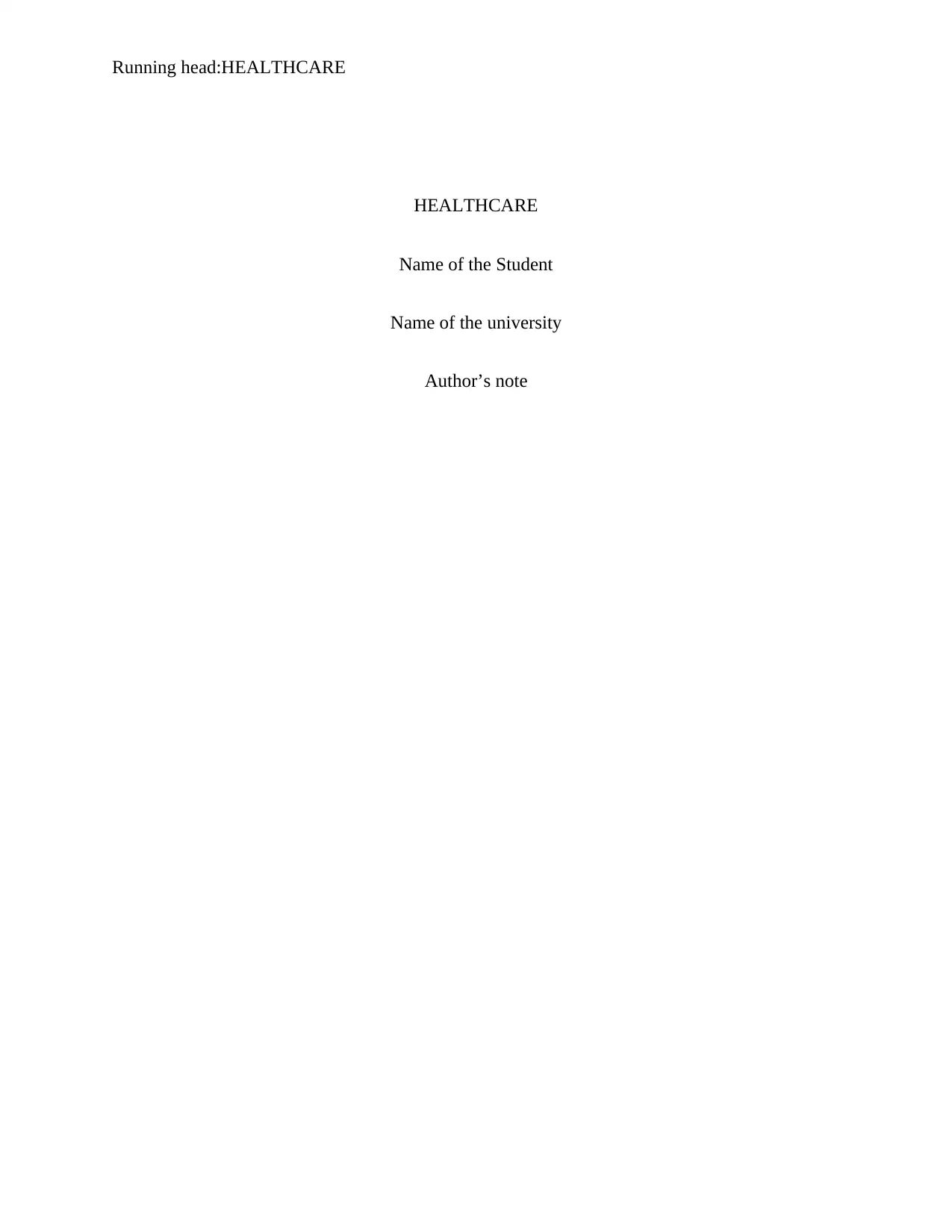
Running head:HEALTHCARE
HEALTHCARE
Name of the Student
Name of the university
Author’s note
HEALTHCARE
Name of the Student
Name of the university
Author’s note
Paraphrase This Document
Need a fresh take? Get an instant paraphrase of this document with our AI Paraphraser
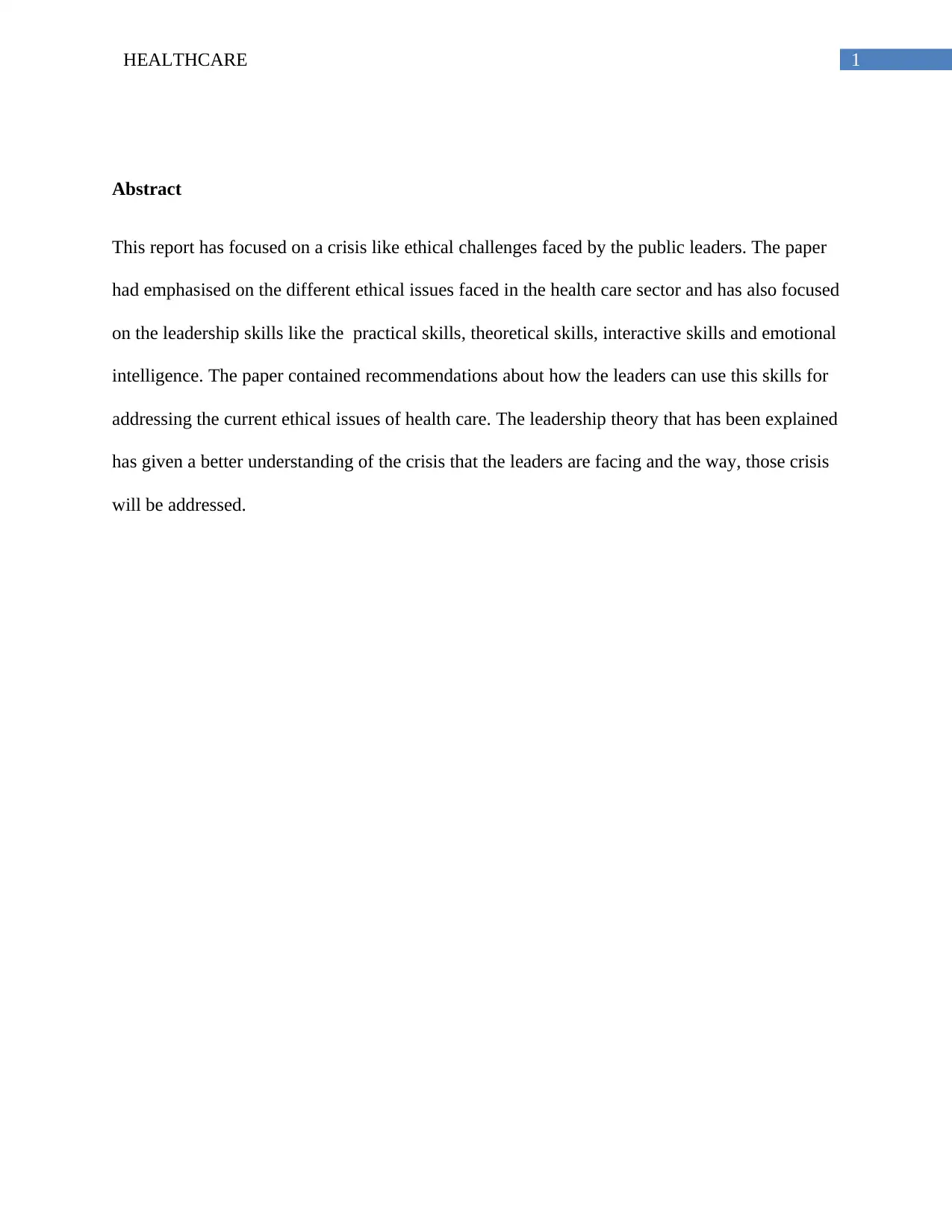
1HEALTHCARE
Abstract
This report has focused on a crisis like ethical challenges faced by the public leaders. The paper
had emphasised on the different ethical issues faced in the health care sector and has also focused
on the leadership skills like the practical skills, theoretical skills, interactive skills and emotional
intelligence. The paper contained recommendations about how the leaders can use this skills for
addressing the current ethical issues of health care. The leadership theory that has been explained
has given a better understanding of the crisis that the leaders are facing and the way, those crisis
will be addressed.
Abstract
This report has focused on a crisis like ethical challenges faced by the public leaders. The paper
had emphasised on the different ethical issues faced in the health care sector and has also focused
on the leadership skills like the practical skills, theoretical skills, interactive skills and emotional
intelligence. The paper contained recommendations about how the leaders can use this skills for
addressing the current ethical issues of health care. The leadership theory that has been explained
has given a better understanding of the crisis that the leaders are facing and the way, those crisis
will be addressed.
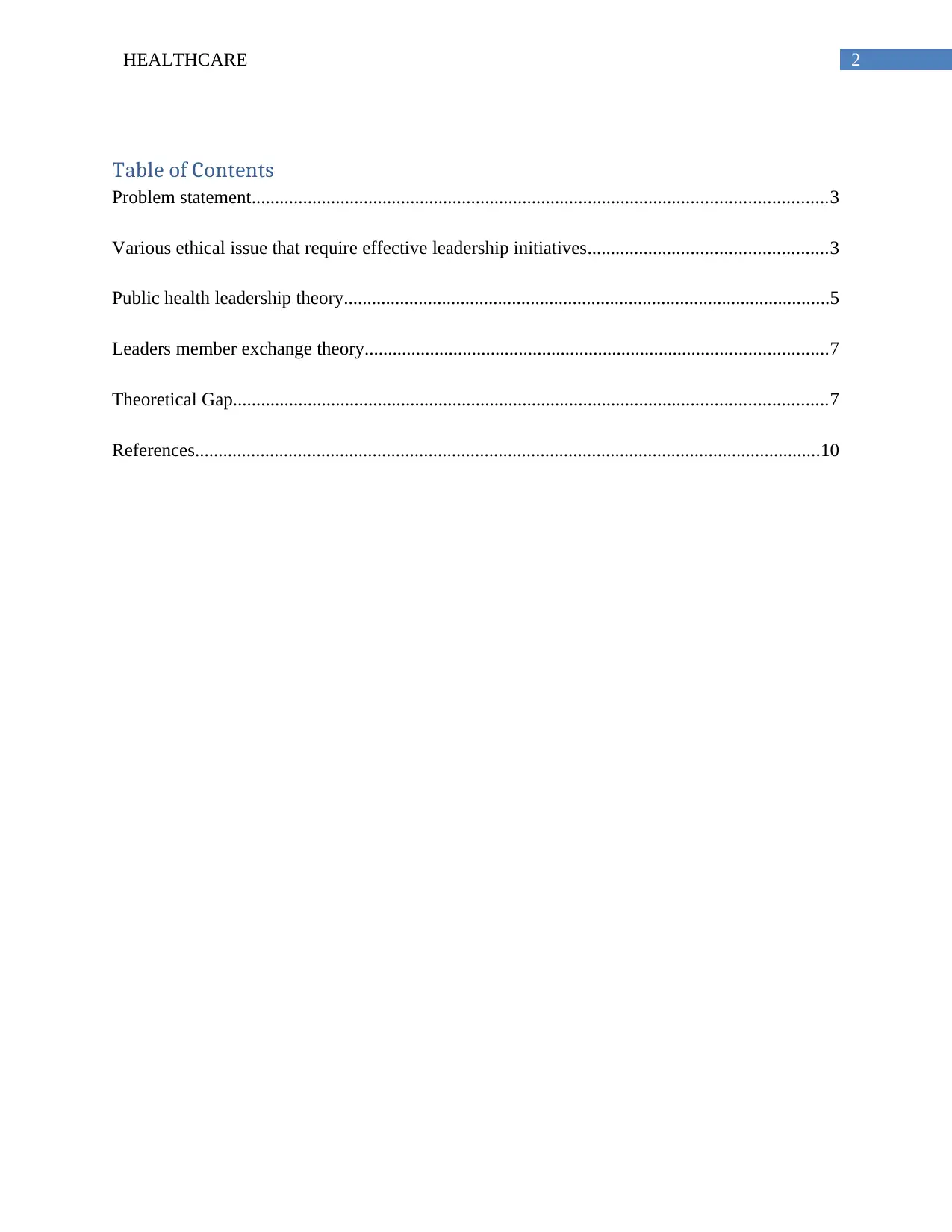
2HEALTHCARE
Table of Contents
Problem statement...........................................................................................................................3
Various ethical issue that require effective leadership initiatives...................................................3
Public health leadership theory........................................................................................................5
Leaders member exchange theory...................................................................................................7
Theoretical Gap...............................................................................................................................7
References......................................................................................................................................10
Table of Contents
Problem statement...........................................................................................................................3
Various ethical issue that require effective leadership initiatives...................................................3
Public health leadership theory........................................................................................................5
Leaders member exchange theory...................................................................................................7
Theoretical Gap...............................................................................................................................7
References......................................................................................................................................10
⊘ This is a preview!⊘
Do you want full access?
Subscribe today to unlock all pages.

Trusted by 1+ million students worldwide
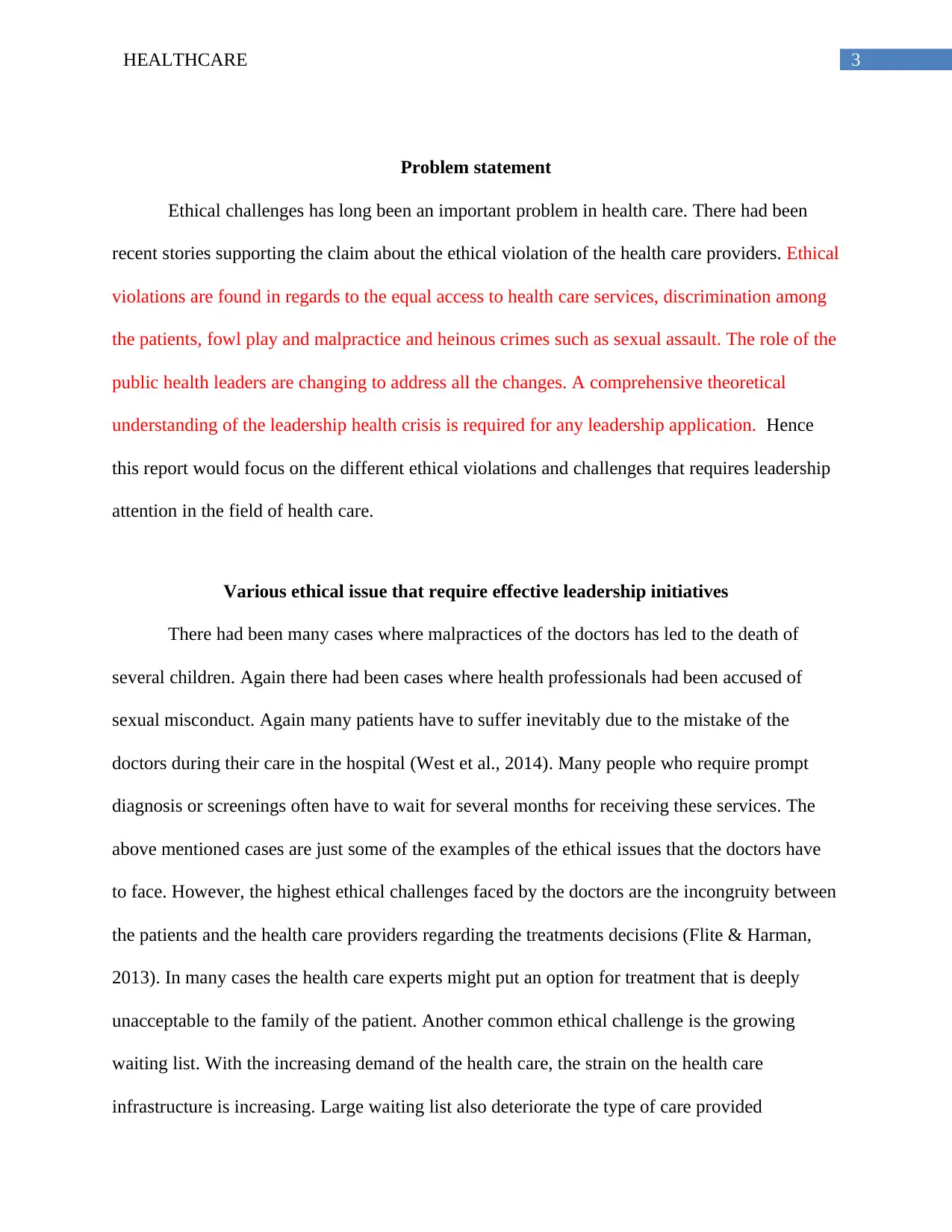
3HEALTHCARE
Problem statement
Ethical challenges has long been an important problem in health care. There had been
recent stories supporting the claim about the ethical violation of the health care providers. Ethical
violations are found in regards to the equal access to health care services, discrimination among
the patients, fowl play and malpractice and heinous crimes such as sexual assault. The role of the
public health leaders are changing to address all the changes. A comprehensive theoretical
understanding of the leadership health crisis is required for any leadership application. Hence
this report would focus on the different ethical violations and challenges that requires leadership
attention in the field of health care.
Various ethical issue that require effective leadership initiatives
There had been many cases where malpractices of the doctors has led to the death of
several children. Again there had been cases where health professionals had been accused of
sexual misconduct. Again many patients have to suffer inevitably due to the mistake of the
doctors during their care in the hospital (West et al., 2014). Many people who require prompt
diagnosis or screenings often have to wait for several months for receiving these services. The
above mentioned cases are just some of the examples of the ethical issues that the doctors have
to face. However, the highest ethical challenges faced by the doctors are the incongruity between
the patients and the health care providers regarding the treatments decisions (Flite & Harman,
2013). In many cases the health care experts might put an option for treatment that is deeply
unacceptable to the family of the patient. Another common ethical challenge is the growing
waiting list. With the increasing demand of the health care, the strain on the health care
infrastructure is increasing. Large waiting list also deteriorate the type of care provided
Problem statement
Ethical challenges has long been an important problem in health care. There had been
recent stories supporting the claim about the ethical violation of the health care providers. Ethical
violations are found in regards to the equal access to health care services, discrimination among
the patients, fowl play and malpractice and heinous crimes such as sexual assault. The role of the
public health leaders are changing to address all the changes. A comprehensive theoretical
understanding of the leadership health crisis is required for any leadership application. Hence
this report would focus on the different ethical violations and challenges that requires leadership
attention in the field of health care.
Various ethical issue that require effective leadership initiatives
There had been many cases where malpractices of the doctors has led to the death of
several children. Again there had been cases where health professionals had been accused of
sexual misconduct. Again many patients have to suffer inevitably due to the mistake of the
doctors during their care in the hospital (West et al., 2014). Many people who require prompt
diagnosis or screenings often have to wait for several months for receiving these services. The
above mentioned cases are just some of the examples of the ethical issues that the doctors have
to face. However, the highest ethical challenges faced by the doctors are the incongruity between
the patients and the health care providers regarding the treatments decisions (Flite & Harman,
2013). In many cases the health care experts might put an option for treatment that is deeply
unacceptable to the family of the patient. Another common ethical challenge is the growing
waiting list. With the increasing demand of the health care, the strain on the health care
infrastructure is increasing. Large waiting list also deteriorate the type of care provided
Paraphrase This Document
Need a fresh take? Get an instant paraphrase of this document with our AI Paraphraser
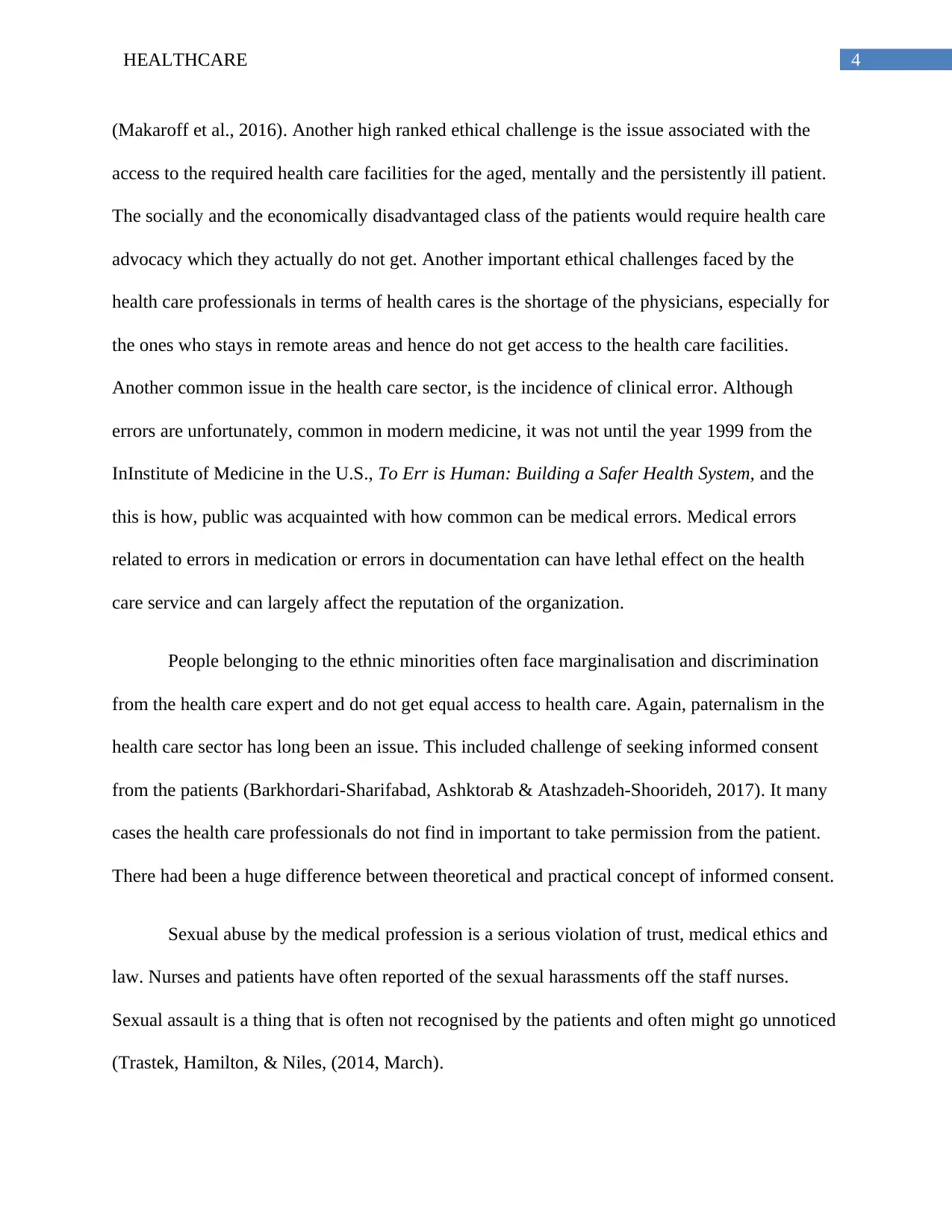
4HEALTHCARE
(Makaroff et al., 2016). Another high ranked ethical challenge is the issue associated with the
access to the required health care facilities for the aged, mentally and the persistently ill patient.
The socially and the economically disadvantaged class of the patients would require health care
advocacy which they actually do not get. Another important ethical challenges faced by the
health care professionals in terms of health cares is the shortage of the physicians, especially for
the ones who stays in remote areas and hence do not get access to the health care facilities.
Another common issue in the health care sector, is the incidence of clinical error. Although
errors are unfortunately, common in modern medicine, it was not until the year 1999 from the
InInstitute of Medicine in the U.S., To Err is Human: Building a Safer Health System, and the
this is how, public was acquainted with how common can be medical errors. Medical errors
related to errors in medication or errors in documentation can have lethal effect on the health
care service and can largely affect the reputation of the organization.
People belonging to the ethnic minorities often face marginalisation and discrimination
from the health care expert and do not get equal access to health care. Again, paternalism in the
health care sector has long been an issue. This included challenge of seeking informed consent
from the patients (Barkhordari-Sharifabad, Ashktorab & Atashzadeh-Shoorideh, 2017). It many
cases the health care professionals do not find in important to take permission from the patient.
There had been a huge difference between theoretical and practical concept of informed consent.
Sexual abuse by the medical profession is a serious violation of trust, medical ethics and
law. Nurses and patients have often reported of the sexual harassments off the staff nurses.
Sexual assault is a thing that is often not recognised by the patients and often might go unnoticed
(Trastek, Hamilton, & Niles, (2014, March).
(Makaroff et al., 2016). Another high ranked ethical challenge is the issue associated with the
access to the required health care facilities for the aged, mentally and the persistently ill patient.
The socially and the economically disadvantaged class of the patients would require health care
advocacy which they actually do not get. Another important ethical challenges faced by the
health care professionals in terms of health cares is the shortage of the physicians, especially for
the ones who stays in remote areas and hence do not get access to the health care facilities.
Another common issue in the health care sector, is the incidence of clinical error. Although
errors are unfortunately, common in modern medicine, it was not until the year 1999 from the
InInstitute of Medicine in the U.S., To Err is Human: Building a Safer Health System, and the
this is how, public was acquainted with how common can be medical errors. Medical errors
related to errors in medication or errors in documentation can have lethal effect on the health
care service and can largely affect the reputation of the organization.
People belonging to the ethnic minorities often face marginalisation and discrimination
from the health care expert and do not get equal access to health care. Again, paternalism in the
health care sector has long been an issue. This included challenge of seeking informed consent
from the patients (Barkhordari-Sharifabad, Ashktorab & Atashzadeh-Shoorideh, 2017). It many
cases the health care professionals do not find in important to take permission from the patient.
There had been a huge difference between theoretical and practical concept of informed consent.
Sexual abuse by the medical profession is a serious violation of trust, medical ethics and
law. Nurses and patients have often reported of the sexual harassments off the staff nurses.
Sexual assault is a thing that is often not recognised by the patients and often might go unnoticed
(Trastek, Hamilton, & Niles, (2014, March).
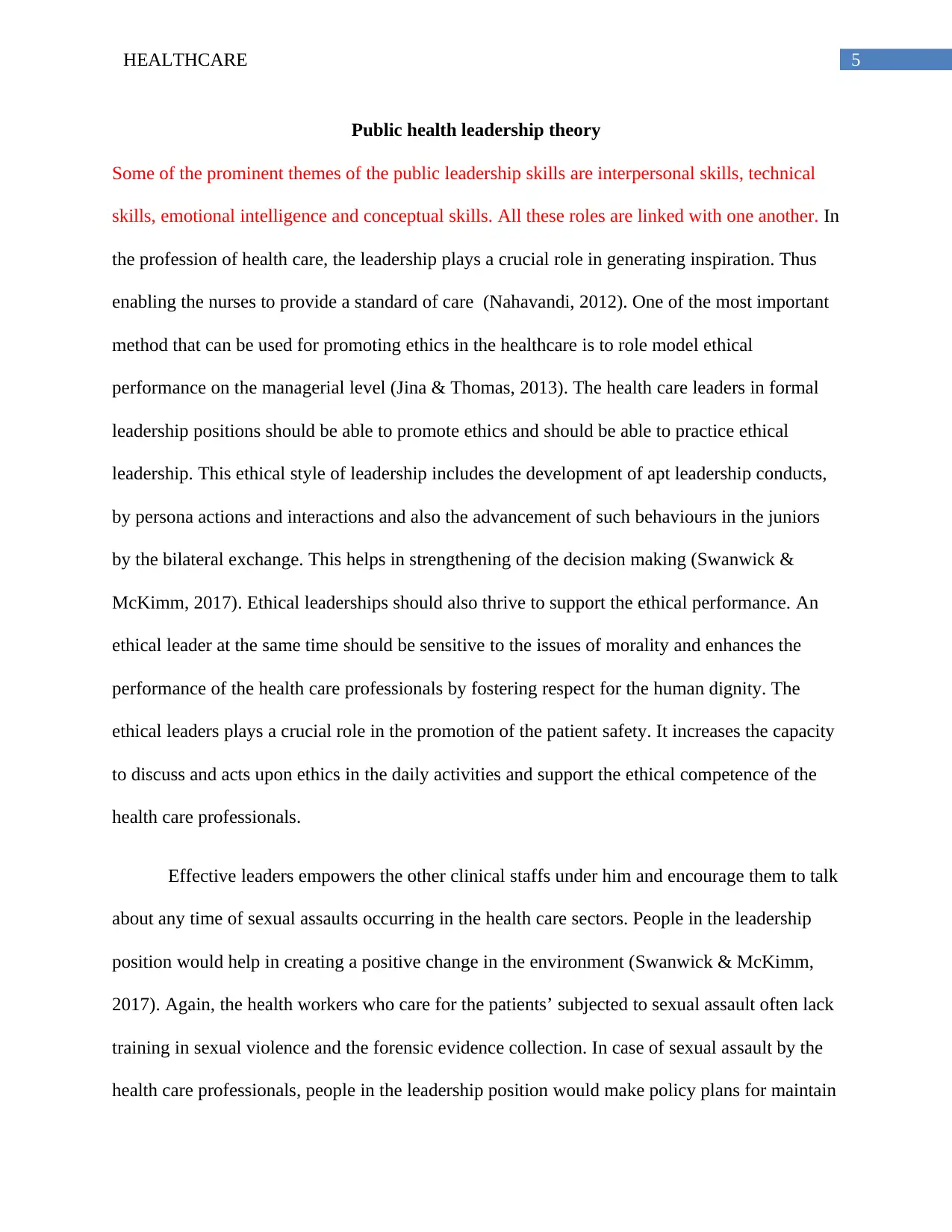
5HEALTHCARE
Public health leadership theory
Some of the prominent themes of the public leadership skills are interpersonal skills, technical
skills, emotional intelligence and conceptual skills. All these roles are linked with one another. In
the profession of health care, the leadership plays a crucial role in generating inspiration. Thus
enabling the nurses to provide a standard of care (Nahavandi, 2012). One of the most important
method that can be used for promoting ethics in the healthcare is to role model ethical
performance on the managerial level (Jina & Thomas, 2013). The health care leaders in formal
leadership positions should be able to promote ethics and should be able to practice ethical
leadership. This ethical style of leadership includes the development of apt leadership conducts,
by persona actions and interactions and also the advancement of such behaviours in the juniors
by the bilateral exchange. This helps in strengthening of the decision making (Swanwick &
McKimm, 2017). Ethical leaderships should also thrive to support the ethical performance. An
ethical leader at the same time should be sensitive to the issues of morality and enhances the
performance of the health care professionals by fostering respect for the human dignity. The
ethical leaders plays a crucial role in the promotion of the patient safety. It increases the capacity
to discuss and acts upon ethics in the daily activities and support the ethical competence of the
health care professionals.
Effective leaders empowers the other clinical staffs under him and encourage them to talk
about any time of sexual assaults occurring in the health care sectors. People in the leadership
position would help in creating a positive change in the environment (Swanwick & McKimm,
2017). Again, the health workers who care for the patients’ subjected to sexual assault often lack
training in sexual violence and the forensic evidence collection. In case of sexual assault by the
health care professionals, people in the leadership position would make policy plans for maintain
Public health leadership theory
Some of the prominent themes of the public leadership skills are interpersonal skills, technical
skills, emotional intelligence and conceptual skills. All these roles are linked with one another. In
the profession of health care, the leadership plays a crucial role in generating inspiration. Thus
enabling the nurses to provide a standard of care (Nahavandi, 2012). One of the most important
method that can be used for promoting ethics in the healthcare is to role model ethical
performance on the managerial level (Jina & Thomas, 2013). The health care leaders in formal
leadership positions should be able to promote ethics and should be able to practice ethical
leadership. This ethical style of leadership includes the development of apt leadership conducts,
by persona actions and interactions and also the advancement of such behaviours in the juniors
by the bilateral exchange. This helps in strengthening of the decision making (Swanwick &
McKimm, 2017). Ethical leaderships should also thrive to support the ethical performance. An
ethical leader at the same time should be sensitive to the issues of morality and enhances the
performance of the health care professionals by fostering respect for the human dignity. The
ethical leaders plays a crucial role in the promotion of the patient safety. It increases the capacity
to discuss and acts upon ethics in the daily activities and support the ethical competence of the
health care professionals.
Effective leaders empowers the other clinical staffs under him and encourage them to talk
about any time of sexual assaults occurring in the health care sectors. People in the leadership
position would help in creating a positive change in the environment (Swanwick & McKimm,
2017). Again, the health workers who care for the patients’ subjected to sexual assault often lack
training in sexual violence and the forensic evidence collection. In case of sexual assault by the
health care professionals, people in the leadership position would make policy plans for maintain
⊘ This is a preview!⊘
Do you want full access?
Subscribe today to unlock all pages.

Trusted by 1+ million students worldwide
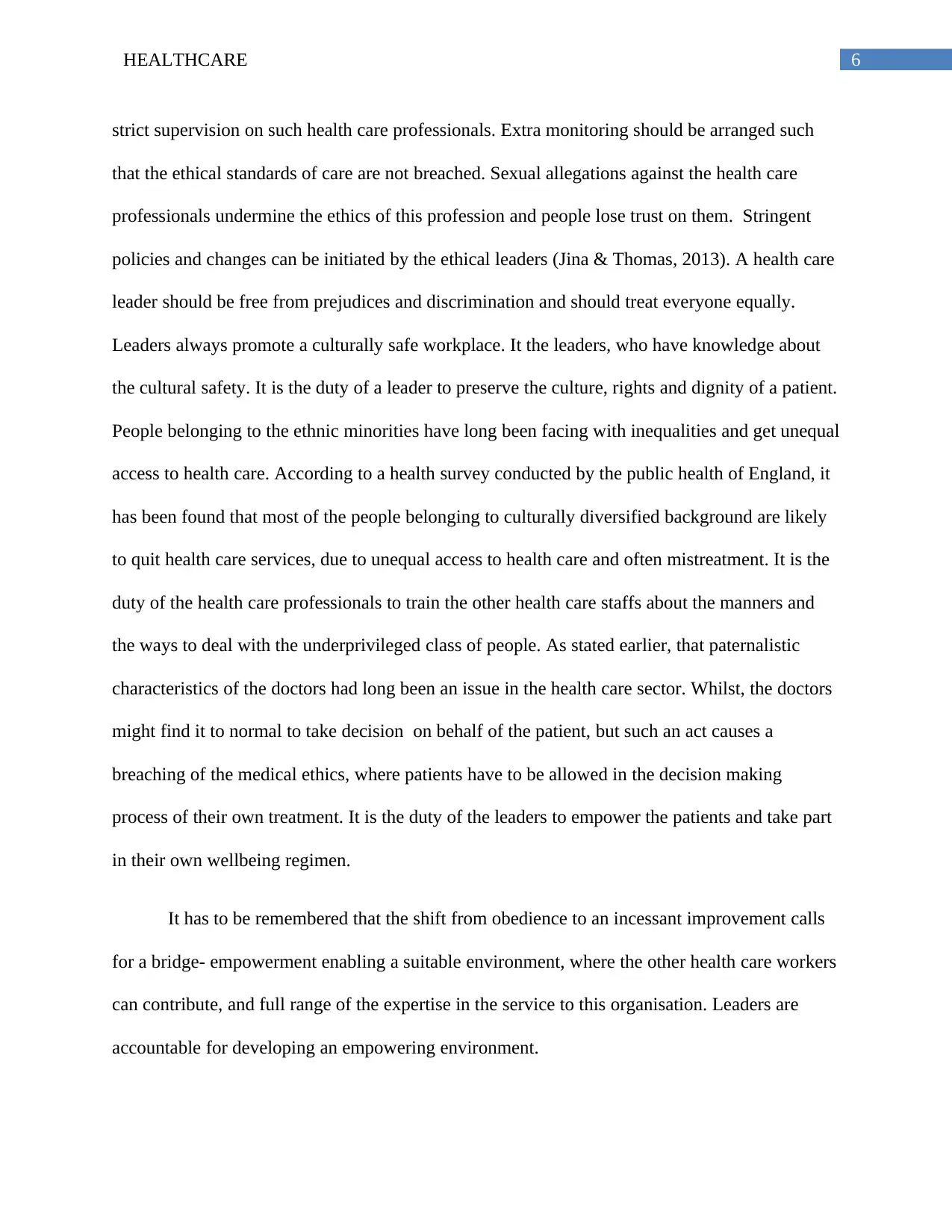
6HEALTHCARE
strict supervision on such health care professionals. Extra monitoring should be arranged such
that the ethical standards of care are not breached. Sexual allegations against the health care
professionals undermine the ethics of this profession and people lose trust on them. Stringent
policies and changes can be initiated by the ethical leaders (Jina & Thomas, 2013). A health care
leader should be free from prejudices and discrimination and should treat everyone equally.
Leaders always promote a culturally safe workplace. It the leaders, who have knowledge about
the cultural safety. It is the duty of a leader to preserve the culture, rights and dignity of a patient.
People belonging to the ethnic minorities have long been facing with inequalities and get unequal
access to health care. According to a health survey conducted by the public health of England, it
has been found that most of the people belonging to culturally diversified background are likely
to quit health care services, due to unequal access to health care and often mistreatment. It is the
duty of the health care professionals to train the other health care staffs about the manners and
the ways to deal with the underprivileged class of people. As stated earlier, that paternalistic
characteristics of the doctors had long been an issue in the health care sector. Whilst, the doctors
might find it to normal to take decision on behalf of the patient, but such an act causes a
breaching of the medical ethics, where patients have to be allowed in the decision making
process of their own treatment. It is the duty of the leaders to empower the patients and take part
in their own wellbeing regimen.
It has to be remembered that the shift from obedience to an incessant improvement calls
for a bridge- empowerment enabling a suitable environment, where the other health care workers
can contribute, and full range of the expertise in the service to this organisation. Leaders are
accountable for developing an empowering environment.
strict supervision on such health care professionals. Extra monitoring should be arranged such
that the ethical standards of care are not breached. Sexual allegations against the health care
professionals undermine the ethics of this profession and people lose trust on them. Stringent
policies and changes can be initiated by the ethical leaders (Jina & Thomas, 2013). A health care
leader should be free from prejudices and discrimination and should treat everyone equally.
Leaders always promote a culturally safe workplace. It the leaders, who have knowledge about
the cultural safety. It is the duty of a leader to preserve the culture, rights and dignity of a patient.
People belonging to the ethnic minorities have long been facing with inequalities and get unequal
access to health care. According to a health survey conducted by the public health of England, it
has been found that most of the people belonging to culturally diversified background are likely
to quit health care services, due to unequal access to health care and often mistreatment. It is the
duty of the health care professionals to train the other health care staffs about the manners and
the ways to deal with the underprivileged class of people. As stated earlier, that paternalistic
characteristics of the doctors had long been an issue in the health care sector. Whilst, the doctors
might find it to normal to take decision on behalf of the patient, but such an act causes a
breaching of the medical ethics, where patients have to be allowed in the decision making
process of their own treatment. It is the duty of the leaders to empower the patients and take part
in their own wellbeing regimen.
It has to be remembered that the shift from obedience to an incessant improvement calls
for a bridge- empowerment enabling a suitable environment, where the other health care workers
can contribute, and full range of the expertise in the service to this organisation. Leaders are
accountable for developing an empowering environment.
Paraphrase This Document
Need a fresh take? Get an instant paraphrase of this document with our AI Paraphraser
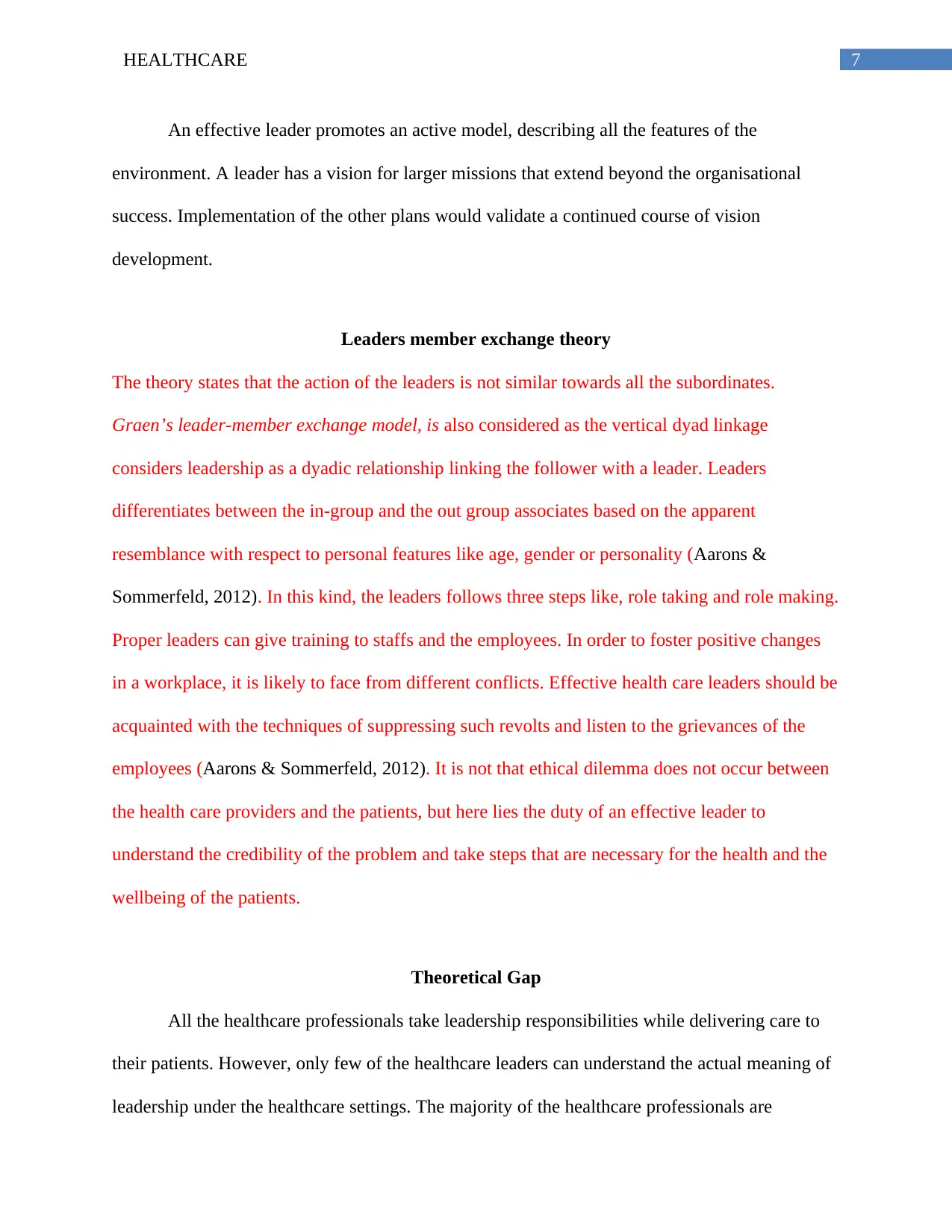
7HEALTHCARE
An effective leader promotes an active model, describing all the features of the
environment. A leader has a vision for larger missions that extend beyond the organisational
success. Implementation of the other plans would validate a continued course of vision
development.
Leaders member exchange theory
The theory states that the action of the leaders is not similar towards all the subordinates.
Graen’s leader-member exchange model, is also considered as the vertical dyad linkage
considers leadership as a dyadic relationship linking the follower with a leader. Leaders
differentiates between the in-group and the out group associates based on the apparent
resemblance with respect to personal features like age, gender or personality (Aarons &
Sommerfeld, 2012). In this kind, the leaders follows three steps like, role taking and role making.
Proper leaders can give training to staffs and the employees. In order to foster positive changes
in a workplace, it is likely to face from different conflicts. Effective health care leaders should be
acquainted with the techniques of suppressing such revolts and listen to the grievances of the
employees (Aarons & Sommerfeld, 2012). It is not that ethical dilemma does not occur between
the health care providers and the patients, but here lies the duty of an effective leader to
understand the credibility of the problem and take steps that are necessary for the health and the
wellbeing of the patients.
Theoretical Gap
All the healthcare professionals take leadership responsibilities while delivering care to
their patients. However, only few of the healthcare leaders can understand the actual meaning of
leadership under the healthcare settings. The majority of the healthcare professionals are
An effective leader promotes an active model, describing all the features of the
environment. A leader has a vision for larger missions that extend beyond the organisational
success. Implementation of the other plans would validate a continued course of vision
development.
Leaders member exchange theory
The theory states that the action of the leaders is not similar towards all the subordinates.
Graen’s leader-member exchange model, is also considered as the vertical dyad linkage
considers leadership as a dyadic relationship linking the follower with a leader. Leaders
differentiates between the in-group and the out group associates based on the apparent
resemblance with respect to personal features like age, gender or personality (Aarons &
Sommerfeld, 2012). In this kind, the leaders follows three steps like, role taking and role making.
Proper leaders can give training to staffs and the employees. In order to foster positive changes
in a workplace, it is likely to face from different conflicts. Effective health care leaders should be
acquainted with the techniques of suppressing such revolts and listen to the grievances of the
employees (Aarons & Sommerfeld, 2012). It is not that ethical dilemma does not occur between
the health care providers and the patients, but here lies the duty of an effective leader to
understand the credibility of the problem and take steps that are necessary for the health and the
wellbeing of the patients.
Theoretical Gap
All the healthcare professionals take leadership responsibilities while delivering care to
their patients. However, only few of the healthcare leaders can understand the actual meaning of
leadership under the healthcare settings. The majority of the healthcare professionals are
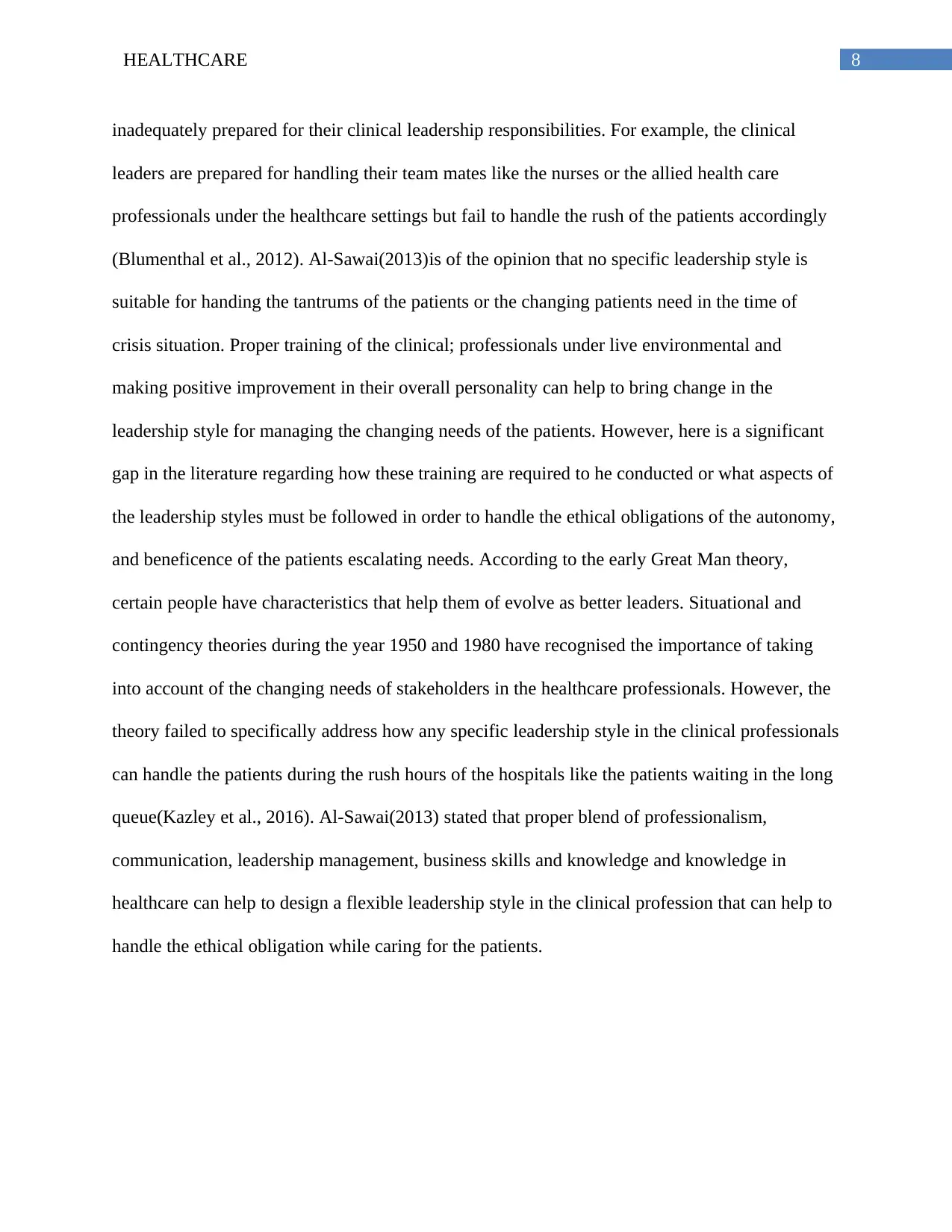
8HEALTHCARE
inadequately prepared for their clinical leadership responsibilities. For example, the clinical
leaders are prepared for handling their team mates like the nurses or the allied health care
professionals under the healthcare settings but fail to handle the rush of the patients accordingly
(Blumenthal et al., 2012). Al-Sawai(2013)is of the opinion that no specific leadership style is
suitable for handing the tantrums of the patients or the changing patients need in the time of
crisis situation. Proper training of the clinical; professionals under live environmental and
making positive improvement in their overall personality can help to bring change in the
leadership style for managing the changing needs of the patients. However, here is a significant
gap in the literature regarding how these training are required to he conducted or what aspects of
the leadership styles must be followed in order to handle the ethical obligations of the autonomy,
and beneficence of the patients escalating needs. According to the early Great Man theory,
certain people have characteristics that help them of evolve as better leaders. Situational and
contingency theories during the year 1950 and 1980 have recognised the importance of taking
into account of the changing needs of stakeholders in the healthcare professionals. However, the
theory failed to specifically address how any specific leadership style in the clinical professionals
can handle the patients during the rush hours of the hospitals like the patients waiting in the long
queue(Kazley et al., 2016). Al-Sawai(2013) stated that proper blend of professionalism,
communication, leadership management, business skills and knowledge and knowledge in
healthcare can help to design a flexible leadership style in the clinical profession that can help to
handle the ethical obligation while caring for the patients.
inadequately prepared for their clinical leadership responsibilities. For example, the clinical
leaders are prepared for handling their team mates like the nurses or the allied health care
professionals under the healthcare settings but fail to handle the rush of the patients accordingly
(Blumenthal et al., 2012). Al-Sawai(2013)is of the opinion that no specific leadership style is
suitable for handing the tantrums of the patients or the changing patients need in the time of
crisis situation. Proper training of the clinical; professionals under live environmental and
making positive improvement in their overall personality can help to bring change in the
leadership style for managing the changing needs of the patients. However, here is a significant
gap in the literature regarding how these training are required to he conducted or what aspects of
the leadership styles must be followed in order to handle the ethical obligations of the autonomy,
and beneficence of the patients escalating needs. According to the early Great Man theory,
certain people have characteristics that help them of evolve as better leaders. Situational and
contingency theories during the year 1950 and 1980 have recognised the importance of taking
into account of the changing needs of stakeholders in the healthcare professionals. However, the
theory failed to specifically address how any specific leadership style in the clinical professionals
can handle the patients during the rush hours of the hospitals like the patients waiting in the long
queue(Kazley et al., 2016). Al-Sawai(2013) stated that proper blend of professionalism,
communication, leadership management, business skills and knowledge and knowledge in
healthcare can help to design a flexible leadership style in the clinical profession that can help to
handle the ethical obligation while caring for the patients.
⊘ This is a preview!⊘
Do you want full access?
Subscribe today to unlock all pages.

Trusted by 1+ million students worldwide
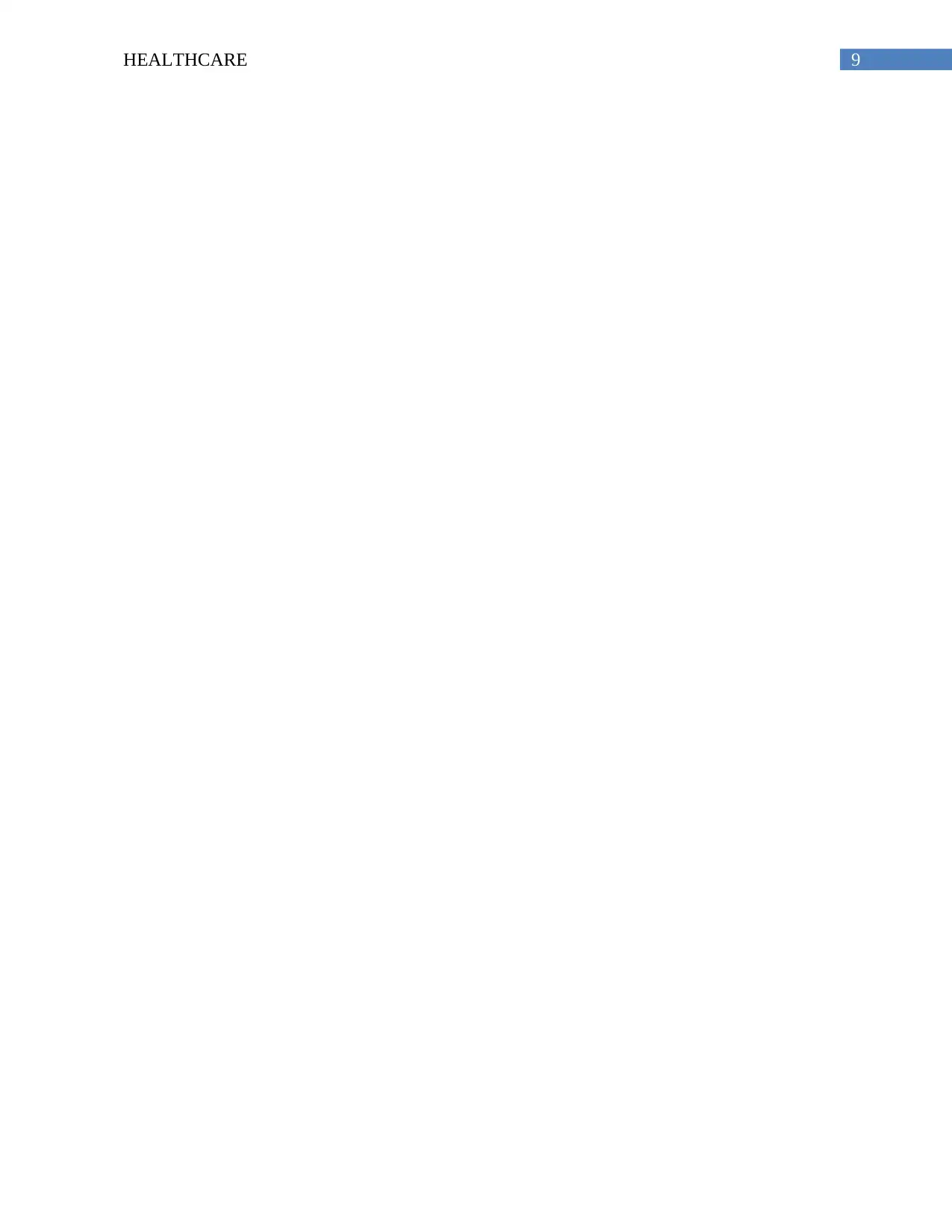
9HEALTHCARE
Paraphrase This Document
Need a fresh take? Get an instant paraphrase of this document with our AI Paraphraser
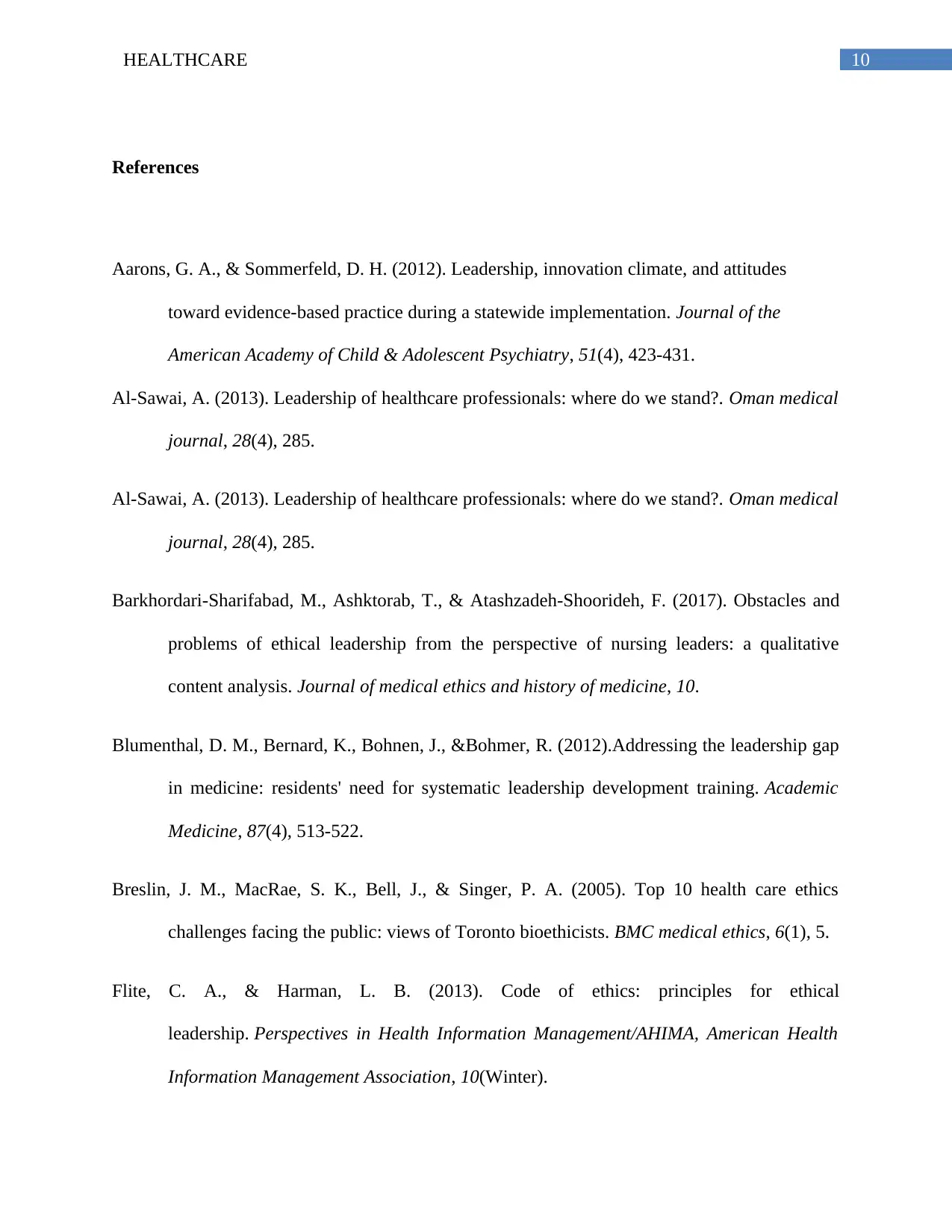
10HEALTHCARE
References
Aarons, G. A., & Sommerfeld, D. H. (2012). Leadership, innovation climate, and attitudes
toward evidence-based practice during a statewide implementation. Journal of the
American Academy of Child & Adolescent Psychiatry, 51(4), 423-431.
Al-Sawai, A. (2013). Leadership of healthcare professionals: where do we stand?. Oman medical
journal, 28(4), 285.
Al-Sawai, A. (2013). Leadership of healthcare professionals: where do we stand?. Oman medical
journal, 28(4), 285.
Barkhordari-Sharifabad, M., Ashktorab, T., & Atashzadeh-Shoorideh, F. (2017). Obstacles and
problems of ethical leadership from the perspective of nursing leaders: a qualitative
content analysis. Journal of medical ethics and history of medicine, 10.
Blumenthal, D. M., Bernard, K., Bohnen, J., &Bohmer, R. (2012).Addressing the leadership gap
in medicine: residents' need for systematic leadership development training. Academic
Medicine, 87(4), 513-522.
Breslin, J. M., MacRae, S. K., Bell, J., & Singer, P. A. (2005). Top 10 health care ethics
challenges facing the public: views of Toronto bioethicists. BMC medical ethics, 6(1), 5.
Flite, C. A., & Harman, L. B. (2013). Code of ethics: principles for ethical
leadership. Perspectives in Health Information Management/AHIMA, American Health
Information Management Association, 10(Winter).
References
Aarons, G. A., & Sommerfeld, D. H. (2012). Leadership, innovation climate, and attitudes
toward evidence-based practice during a statewide implementation. Journal of the
American Academy of Child & Adolescent Psychiatry, 51(4), 423-431.
Al-Sawai, A. (2013). Leadership of healthcare professionals: where do we stand?. Oman medical
journal, 28(4), 285.
Al-Sawai, A. (2013). Leadership of healthcare professionals: where do we stand?. Oman medical
journal, 28(4), 285.
Barkhordari-Sharifabad, M., Ashktorab, T., & Atashzadeh-Shoorideh, F. (2017). Obstacles and
problems of ethical leadership from the perspective of nursing leaders: a qualitative
content analysis. Journal of medical ethics and history of medicine, 10.
Blumenthal, D. M., Bernard, K., Bohnen, J., &Bohmer, R. (2012).Addressing the leadership gap
in medicine: residents' need for systematic leadership development training. Academic
Medicine, 87(4), 513-522.
Breslin, J. M., MacRae, S. K., Bell, J., & Singer, P. A. (2005). Top 10 health care ethics
challenges facing the public: views of Toronto bioethicists. BMC medical ethics, 6(1), 5.
Flite, C. A., & Harman, L. B. (2013). Code of ethics: principles for ethical
leadership. Perspectives in Health Information Management/AHIMA, American Health
Information Management Association, 10(Winter).
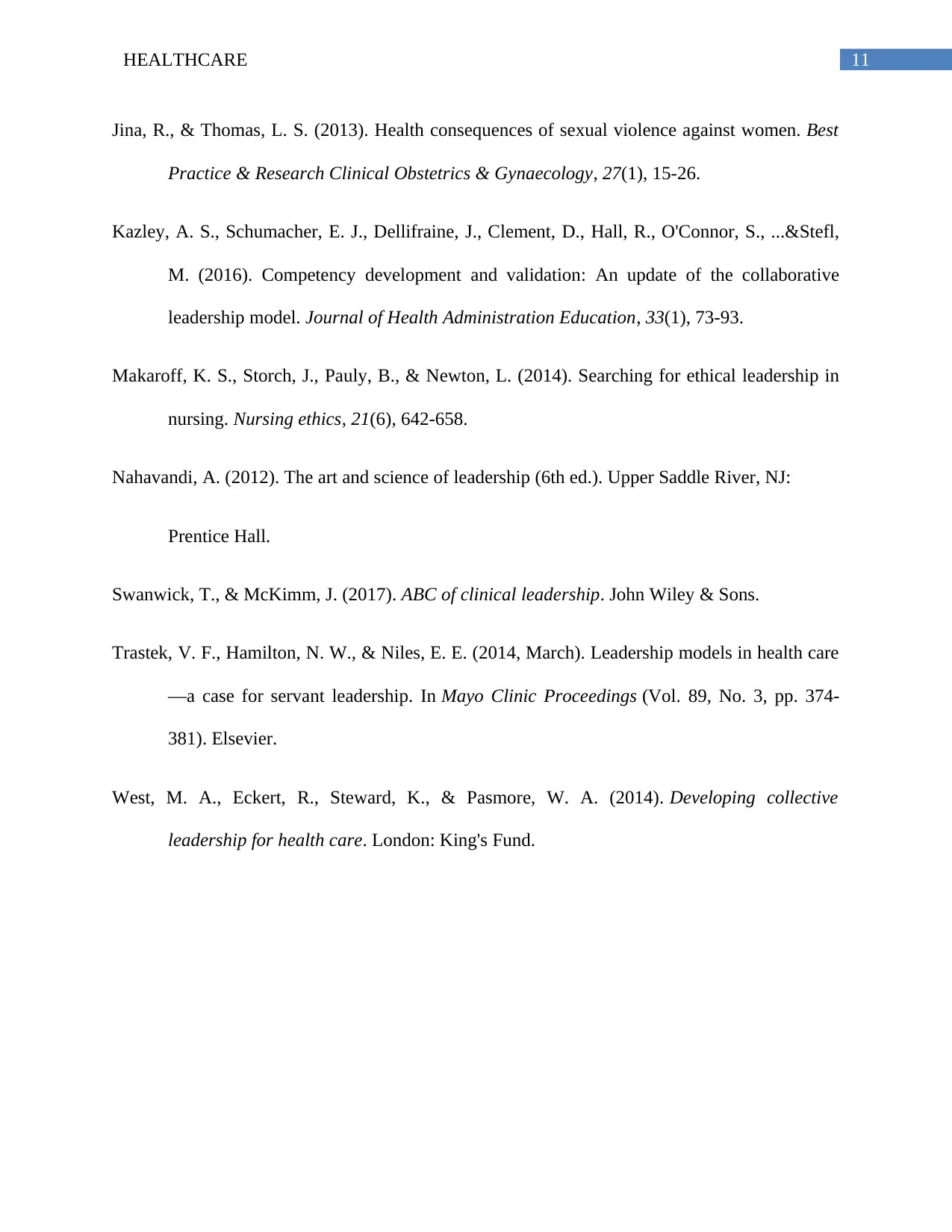
11HEALTHCARE
Jina, R., & Thomas, L. S. (2013). Health consequences of sexual violence against women. Best
Practice & Research Clinical Obstetrics & Gynaecology, 27(1), 15-26.
Kazley, A. S., Schumacher, E. J., Dellifraine, J., Clement, D., Hall, R., O'Connor, S., ...&Stefl,
M. (2016). Competency development and validation: An update of the collaborative
leadership model. Journal of Health Administration Education, 33(1), 73-93.
Makaroff, K. S., Storch, J., Pauly, B., & Newton, L. (2014). Searching for ethical leadership in
nursing. Nursing ethics, 21(6), 642-658.
Nahavandi, A. (2012). The art and science of leadership (6th ed.). Upper Saddle River, NJ:
Prentice Hall.
Swanwick, T., & McKimm, J. (2017). ABC of clinical leadership. John Wiley & Sons.
Trastek, V. F., Hamilton, N. W., & Niles, E. E. (2014, March). Leadership models in health care
—a case for servant leadership. In Mayo Clinic Proceedings (Vol. 89, No. 3, pp. 374-
381). Elsevier.
West, M. A., Eckert, R., Steward, K., & Pasmore, W. A. (2014). Developing collective
leadership for health care. London: King's Fund.
Jina, R., & Thomas, L. S. (2013). Health consequences of sexual violence against women. Best
Practice & Research Clinical Obstetrics & Gynaecology, 27(1), 15-26.
Kazley, A. S., Schumacher, E. J., Dellifraine, J., Clement, D., Hall, R., O'Connor, S., ...&Stefl,
M. (2016). Competency development and validation: An update of the collaborative
leadership model. Journal of Health Administration Education, 33(1), 73-93.
Makaroff, K. S., Storch, J., Pauly, B., & Newton, L. (2014). Searching for ethical leadership in
nursing. Nursing ethics, 21(6), 642-658.
Nahavandi, A. (2012). The art and science of leadership (6th ed.). Upper Saddle River, NJ:
Prentice Hall.
Swanwick, T., & McKimm, J. (2017). ABC of clinical leadership. John Wiley & Sons.
Trastek, V. F., Hamilton, N. W., & Niles, E. E. (2014, March). Leadership models in health care
—a case for servant leadership. In Mayo Clinic Proceedings (Vol. 89, No. 3, pp. 374-
381). Elsevier.
West, M. A., Eckert, R., Steward, K., & Pasmore, W. A. (2014). Developing collective
leadership for health care. London: King's Fund.
⊘ This is a preview!⊘
Do you want full access?
Subscribe today to unlock all pages.

Trusted by 1+ million students worldwide
1 out of 12
Related Documents
Your All-in-One AI-Powered Toolkit for Academic Success.
+13062052269
info@desklib.com
Available 24*7 on WhatsApp / Email
![[object Object]](/_next/static/media/star-bottom.7253800d.svg)
Unlock your academic potential
Copyright © 2020–2025 A2Z Services. All Rights Reserved. Developed and managed by ZUCOL.





